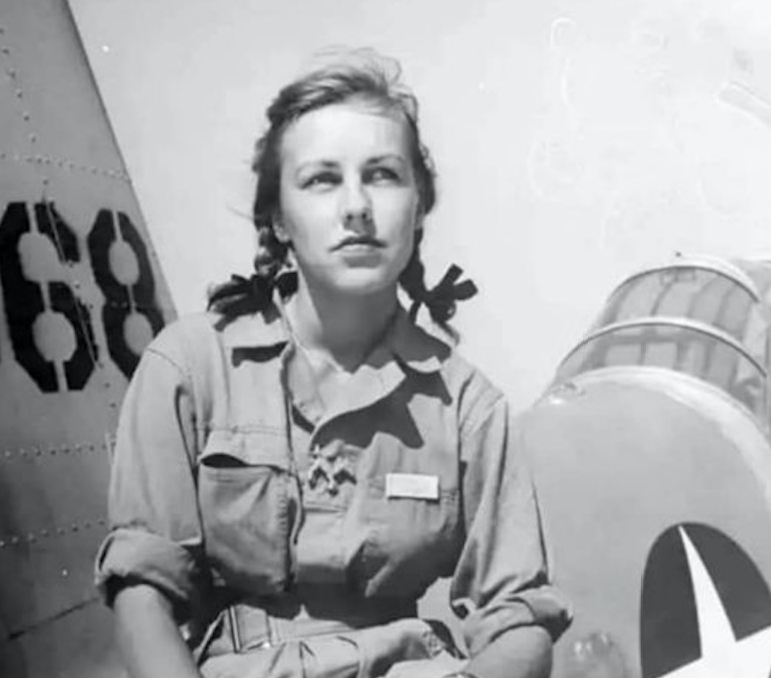[ad_1]
When we talk about the heroes of World War II, we often think of the battles, the generals, the troops who stormed beaches and held the line.
But there’s another kind of hero—one whose legacy took decades to be fully recognized. One who soared thousands of feet above the front lines, ferrying bombers, training other pilots, and doing it all without fanfare or military status.
Shirley Slade was one of them.
A Different Kind of Battlefield

Born on 4 April 1921 in Chicago, Shirley Slade (later Shirley Slade Teer) grew up in a world where girls weren’t supposed to dream of flying planes—especially not military aircraft. But she did.
And when the United States entered World War II and faced a desperate shortage of pilots, Shirley didn’t hesitate.
Like more than 25,000 American women, she answered the call to fly. Only 1,830 were accepted into the Women Airforce Service Pilots (WASP) program, and just 1,074 completed the intense training, which lasted anywhere between 21 and 27 weeks.
Shirley was one of them.
She joined Class 43-5, training at Dodge City Army Airfield in Kansas, Harlingen Army Airfield in Texas, and Love Field in Dallas. She learned to fly some of the most challenging aircraft of the era, including the Bell P-39 Airacobra and the Martin B-26 Marauder—a bomber so dangerous it earned the nickname “Widowmaker.”
But Shirley wasn’t intimidated. In fact, she was one of only 25 women handpicked by WASP Director Jacqueline Cochran—at the request of General Henry “Hap” Arnold—to prove that the B-26, a plane many men refused to fly due to its safety record, could be flown safely. And prove it she did.
With grit, precision, and unwavering focus, she showed the world it could be done. After all, lives depended on it.
She proved it with grit, precision, and unwavering focus—because lives depended on it.
A Face for the Future

On 19 July 1943, Shirley’s story—and her face—reached the nation when she appeared on the cover of LIFE Magazine. In the now-iconic photo, she stands tall on the wing of a military aircraft, flight suit on, wind in her hair, eyes steady. Her expression is calm but determined. The cover headline: “Girl Pilots.” In small letters on the lower left-hand corner of the magazine cover, it said “Air Force Pilot.”
She wasn’t just representing herself. She represented every woman who had been told “no” and flew anyway.
That cover was a quiet revolution. It said: Look what women can do.
Flying with Purpose

The WASP program was as grueling as it was groundbreaking. Candidates had to be between 21 and 35 years old, over 5’4″, and high school graduates. They paid for their own training and travel. They studied meteorology, Morse code, military law, physics, navigation, and aircraft mechanics. They logged 560 hours of ground school and 210 hours of flight training. And then they went to work.
WASPs ferried more than 12,600 aircraft, often flying solo from factories to staging points across the country before the transatlantic hop. They logged over 60 million miles. They transported cargo, including parts for the atomic bomb. They towed targets for live anti-aircraft gun practice, flew simulated strafing missions, and tested brand-new aircraft.
They did everything male pilots did except fly in combat.
And they did it without rank, without benefits, and without recognition.
Invisible Sacrifice

When the WASP program ended on 20 December 1944, 38 women had lost their lives in service. There were no military funerals. No Gold Stars. No veterans’ benefits for the families they left behind. Families weren’t even allowed to drape a flag over the coffins.
Shirley Slade and her fellow WASPs went home quietly, their uniforms packed away, their stories largely forgotten. Their contributions were classified and hidden from public view for decades—a shameful reminder of how women’s service was often dismissed or erased.
Recognition, at Last
It took more than 30 years for that to start to change.
In 1977, President Jimmy Carter signed legislation granting the WASPs veteran status. And in 2009—65 years after the program was shut down—Congress awarded the surviving WASPs the Congressional Gold Medal. Only about 200 were still alive to receive it.
Shirley wasn’t among them. She passed away on 26 April 2000, at age 79, in Texas. She never got to hear a nation say “thank you.”
But her legacy lives on.
More Than a Pilot
Shirley Slade wasn’t just a pilot. She was a pioneer. A patriot. A woman who saw a barrier and flew straight through it.
Her story—like so many others in the WASP program—isn’t just about planes or war. It’s about the quiet strength it takes to show up when no one expects you to. It’s about standing on the wing of a bomber and looking toward a future you’re helping shape. It’s about believing that courage has no gender.
A Tribute, and a Promise

Today, when we honor the Armed Forces and the sacrifices so many have made for the freedoms we hold dear, we remember women like Shirley Slade, who flew not for glory or recognition but out of a deep love for their country. They showed us that strength comes in many forms and that heroes aren’t always the ones with medals.
Sometimes, they’re the ones whose names we’re only just beginning to learn.
We owe it to them and future generations to keep telling their stories.
Because Shirley Slade didn’t just help win a war. She helped open the skies.
[ad_2]
Source link


